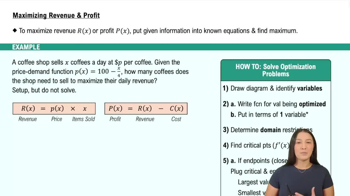Table of contents
- 0. Functions7h 52m
- Introduction to Functions16m
- Piecewise Functions10m
- Properties of Functions9m
- Common Functions1h 8m
- Transformations5m
- Combining Functions27m
- Exponent rules32m
- Exponential Functions28m
- Logarithmic Functions24m
- Properties of Logarithms34m
- Exponential & Logarithmic Equations35m
- Introduction to Trigonometric Functions38m
- Graphs of Trigonometric Functions44m
- Trigonometric Identities47m
- Inverse Trigonometric Functions48m
- 1. Limits and Continuity2h 2m
- 2. Intro to Derivatives1h 33m
- 3. Techniques of Differentiation3h 18m
- 4. Applications of Derivatives2h 38m
- 5. Graphical Applications of Derivatives6h 2m
- 6. Derivatives of Inverse, Exponential, & Logarithmic Functions2h 37m
- 7. Antiderivatives & Indefinite Integrals1h 26m
- 8. Definite Integrals4h 44m
- 9. Graphical Applications of Integrals2h 27m
- 10. Physics Applications of Integrals 2h 22m
5. Graphical Applications of Derivatives
Applied Optimization
Problem 4.5.56
Textbook Question
Snell’s Law Suppose a light source at A is in a medium in which light travels at a speed v₁ and that point B is in a medium in which light travels at a speed v₂ (see figure). Using Fermat’s Principle, which states that light travels along the path that requires the minimum travel time (Exercise 55), show that the path taken between points A and B satisfies (sinΘ₁/v₁ = (sin Θ₂) /v₂ . <IMAGE>
 Verified step by step guidance
Verified step by step guidance1
Start by understanding Fermat's Principle, which states that light travels between two points along the path that requires the least time. This principle will guide us in deriving Snell's Law.
Consider the path of light traveling from point A in medium 1 to point B in medium 2. Let the point where the light crosses the boundary between the two media be point P. The total travel time T is the sum of the time taken in each medium.
Express the travel time in each medium. In medium 1, the time taken is T₁ = d₁/v₁, where d₁ is the distance traveled in medium 1. Similarly, in medium 2, the time taken is T₂ = d₂/v₂, where d₂ is the distance traveled in medium 2.
To find the path that minimizes the total travel time T = T₁ + T₂, apply calculus. Use the fact that the derivative of T with respect to the position of point P must be zero for the time to be minimized.
By applying the calculus of variations or using the geometry of the situation, derive the relationship between the angles of incidence and refraction, leading to the equation (sinΘ₁/v₁) = (sinΘ₂/v₂), which is Snell's Law.
 Verified video answer for a similar problem:
Verified video answer for a similar problem:This video solution was recommended by our tutors as helpful for the problem above
Video duration:
10mPlay a video:
Was this helpful?
Key Concepts
Here are the essential concepts you must grasp in order to answer the question correctly.
Fermat's Principle
Fermat's Principle states that light travels between two points along the path that requires the least time. This principle can be applied to derive the laws of reflection and refraction, as it implies that the actual path taken by light minimizes the travel time, leading to the formulation of Snell's Law in the context of different media.
Recommended video:

Inverse Sine
Snell's Law
Snell's Law describes how light refracts when it passes from one medium to another, relating the angles of incidence and refraction to the speeds of light in the respective media. Mathematically, it is expressed as sin(Θ₁)/v₁ = sin(Θ₂)/v₂, where Θ₁ and Θ₂ are the angles of incidence and refraction, and v₁ and v₂ are the speeds of light in the first and second media, respectively.
Refraction
Refraction is the bending of light as it passes from one medium to another due to a change in its speed. This phenomenon is crucial in understanding how light behaves at the interface of different materials, and it is governed by Snell's Law, which quantitatively describes the relationship between the angles of incidence and refraction based on the indices of refraction of the two media.

 1:13m
1:13mWatch next
Master Intro to Applied Optimization: Maximizing Area with a bite sized video explanation from Callie
Start learningRelated Videos
Related Practice









